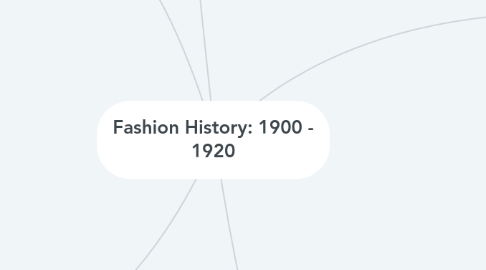
1. Note Worthy Fashion Events
1.1. 1902 - JcPenney opened the first department store in US
1.1.1. Now a midscale American department store chain.
1.2. 1909 - Selfridges open
1.2.1. Now a chain of high-end department stores.
1.3. 1908 - House of Lucile introduces the 'mannequin parade' - also known as the original catwalk.
2. Important Fashion Inventions
2.1. Mariano Fortuny's pleating
2.1.1. His signature were his Delphos gowns.
2.1.1.1. Long and clothes to the body made of single column finely pleated silk.
2.2. 1905 - Viscose fabric was created (artificial silk)
2.2.1. Sold commercially for undergarments
2.2.2. Introduced in the US in 1910
2.2.3. Renamed to Rayon in the 20s
2.3. 1913 - zippers were invented.
2.3.1. First used in 1920 to close rubber boots.
2.4. 1914 - the first modern brasier was patterned by Mary Phelps Jacobs
2.4.1. Corsets were no longer suitable for the lighter garments.
2.5. 1914 - Invention of trench coats.
2.5.1. Burberry was commissioned to adapt the army officers coats.
2.5.1.1. Made them more practical.
3. Fashion Trends of the Time
3.1. Straight front corset: 1900 - 1910
3.1.1. Forced the torso forwards and made the hips protrude back.
3.1.1.1. Created an 's' shape silhouette .
3.1.1.2. Like a bird's chest.
3.2. During the 1910 skirts were just above floor length or ankle length.
3.3. Leading up to WW1 silhouettes straightened and became more relaxed
3.3.1. Corsets were replaced by brasiers
3.3.2. clothes had many layers of sheer fabrics decorated with lace panels and embroidery
3.4. For bicycling and hiking, women would wear divided skirts or bloomers gathered bellow the knee.
3.4.1. Stockings and shortened corsets were warn underneath the garments.
3.5. Bathing suits had short sleeves and covered the knees.
3.6. Extravagant and large hats were always warn.
3.7. For shoes women would wear 2 inch curved
3.8. During 1914 and onwards (WW1), women picked up jobs and had specific uniforms for each job.
3.8.1. Clothes were simpler, darker and more practical.
3.8.2. uniform element were incorporated into everyday attire.
3.9. In 1915 the influential French magazine 'Gazette de bon Temp' published full skirts with hem lines above the ankles known as War Crinolines.
3.9.1. This was seen as patriotic and practical.
3.10. Men' wear did not change much.
3.10.1. Men still war dark, 3 piece suits
3.10.2. Formal coats without tail (known as tuxedo jackets) were now considered formal wear.
3.10.3. men used accessories such as umbrellas , hats, watch chains and canes
3.10.4. Men would wear bow ties and cravats.
3.10.5. For sports, they would wear knee length trousers with thick socks.
4. Designers of the Time
4.1. Jeanne Paquin - female designer (1890)
4.1.1. Made black a fashionable colour
4.1.2. started her work using pastels colours but later used a lot of red.
4.1.3. In 1906, she re-introduced the empire waist gown originally warn between 1811 and 1820.
4.2. Paul Poiret opened his own fashion house (1903 - 1929)
4.2.1. Promoted loose, lean line garments
4.2.2. No corsets or petticoats
4.2.3. In 1913 he made the debute of lampshads
4.3. Madelaine Vionnet opened her own fashion store in 1912 - 1914 and re-opened in 1923.
4.3.1. Very feminine gowns with beautifully draped fabrics.
4.3.2. Later on in her career was greately inspired by Greece
4.4. Jeanne Patou reopened his store in 1919
4.4.1. He looked for natural silhouette and comfort.
4.5. Coco Chanel also opened her couture house in 1919
4.5.1. Started off with selling hats in 1910.
4.5.2. After 1919 started selling clothes.
5. Major Fashion Movements
5.1. La Belle Epoque: 1871 - 1914
5.1.1. End of France Oppression war - beginning of WW1.
5.1.2. Refers to the western world, but sometimes more specifically for France.
5.2. Gibson Girl: 1895 - 1915
5.2.1. Concept created by an American illustrator Charles Dana Gibson
5.2.2. Tall slender women with tiny waste and piles of perfect hair.
5.2.2.1. hard to achieve but aspirational beauty standard.
5.3. Edwardian Era: 1901 - 1915
5.3.1. Refers to British fashion specifically. Began in the late 1890s.
5.3.1.1. Used the straight front corset to create an 's' line silhouette.
5.4. Orientalism: 1909 - 1926
5.4.1. Inspired by the first performance of the Ballet Russes in Paris
5.4.1.1. Their costumes had middle-eastern and Asian motives, bright colours and turbans.
5.4.1.1.1. Greatly influence fashion all over Europe.
5.4.2. Paul Poiret most well known for his oriental inspired designs.
